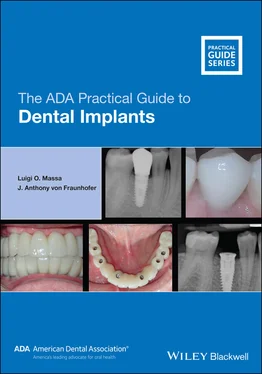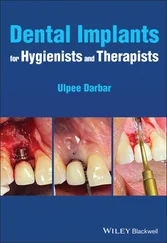13 13. Ravidà, A., Tattan, M., Askar, H. et al. (2019). Comparison of three different types of implant‐supported fixed dental prostheses: a long‐term retrospective study of clinical outcomes and cost‐effectiveness. Clin. Oral Implants Res. 30 (4): 295–305.
14 14. Oh, S.‐H., Kim, Y., Park, J.‐Y. et al. (2016). Comparison of fixed implant‐supported prostheses, removable implant‐supported prostheses, and complete dentures: patient satisfaction and oral health‐related quality of life. Clin. Oral Implants Res. 27 (2): e31–e37.
2 A Brief History of Dental Implants
Dentistry has a venerable history in that prosthodontics has been practiced for several thousand years. Fine examples of dental bridgework dating from around 700 BCE were crafted by the Etruscans of Central Italy (now Tuscany) and fixed partial dentures are known to have been fabricated by the Maya of Central America as far back as 700 CE [1–4]. There are many well‐known figures in history, for example, Queen Elizabeth I of England, King Henry II of France, George Washington of the United States and Winston Churchill of the United Kingdom, all of whom either wore removable partial dentures (RPDs) or complete dentures (CDs) [3].
The “father” of dentistry is generally acknowledged to be the French physician Pierre Fauchard (1678–1761) [2] whereas most historians and dentists credit Dr. Greene Vardiman Black (1836–1915) [2, 5, 6] as the “father of modern dentistry.” There are a number of other pioneers in dentistry, including the illustrious Scottish surgeon John Hunter, an early advocate of careful observation and scientific observation in medicine. Not only did Hunter collaborate with his former student Edward Jenner, the pioneer of the smallpox vaccine, but he also dabbled (unsuccessfully) with transplanting teeth, possibly following on from the work of Ambroise Paré (1510–1590). Paré is recognized as the “Father of Modern Surgery” and, interestingly, as the “Foster Father of Dental Surgery.” Interestingly, Paré referred to transplanting of teeth as early as 1564.
Despite its venerable history, the greatest advances in dentistry have really only occurred within the latter half of the twentieth century and, notably, the past 50–60 years. Many influences have transformed dentistry from an ancient quasi‐craft into the evidence‐based technological science it is today, including the innovative work of early dental practitioners, advances in oral medicine, oral surgery and restorative dental techniques, together with an astonishing array of scientific and technology‐driven progress in dental science and dental biomaterials. Table 2.1indicates a significant number of innovations that have changed modern dentistry, one of which is the endosseous dental implant.
Table 2.1Innovations in dentistry and dental care.
| Acrylic resin Adhesive dentistry Air‐turbine handpieces |
| Bowen's resin Computer‐aided designed/computer‐aided manufactured restorations Chromium‐cobalt casting alloys Composite restorative materials Cosmetic dentistry Dental Amalgam Digital radiography |
| Direct bonding of orthodontic brackets |
| Electric high‐torque/high‐speed handpieces Endodontic therapy |
| Endosseous oral implants |
| Fluoride‐containing dentifrices |
| Glass ionomers High‐strength dental ceramics |
| Mechanical toothbrushes |
| Orthognathic surgery |
| Porcelain fused to metal restorations Silver‐palladium alloys Visible light‐cured restorative materials Water fluoridation |
The confluence of the advances in the basic sciences, dental biomaterials and clinical technique possibly reached their apex in the endosseous dental implant, perhaps the most successful dental restorative technique ever devised. Virtually no other dental procedure has achieved the long‐term success rate found over the past 15–20 years with dental implants.
The efforts of Ambroise Paré, John Hunter and others to replace missing teeth through implantation of sound teeth from donors were the initial attempts to address this need in patients. Dentures, as such, were not available for the general populace back in the fifteenth and sixteenth centuries and only the very wealthy could avail themselves of transplanted teeth or the rudimentary dentures of that period. Charles Allen of York, England, the author of the first English book solely on dentistry [7] was very dismissive of tooth transplantation.
Patients seemed to accept the limited durability of transplanted teeth and transplantation, probably due to clever publicity and hucksterism, became almost a craze on the European Continent, in England and even America in the late eighteenth century. Sadly, through the sixteenth, seventeenth, and eighteenth centuries, paupers often sold their teeth for cash to earn a little money and the heroine Fantine in Victor Hugo's Les Misérables (1852) was forced to sell her hair, then her incisors and finally her “virtue” in order to survive. Despite its lack of success and almost total disregard of the basic precepts of oral hygiene, tooth transplanting continued well into the nineteenth century. In fact, barrels of teeth extracted from casualties in the American Civil War were regularly shipped to England, and presumably Europe, for both transplantation and to be used in constructing dentures.
This situation changed with the advent of dental schools, the establishment of professional standards and the growing awareness of the general public that dentistry, dental care and oral hygiene were important not only to the oral cavity but also to systemic health. Nevertheless, despite the venerable history of dentures and the remarkable success of modern CDs, FPDs, and RPDs, many patients simply do not like the fact that they must resort to prostheses to preserve masticatory efficiency and maintain facial esthetics. As any dental professional recognizes, there are myriad reasons that patients complain about their dentures. Many complaints, arising from poor denture fit, discomfort, inadequate retention and even pain, are completely understandable and often justified whereas others arise from a basic dislike of a “foreign body” in the mouth. Further, the need for careful oral hygiene and meticulous cleaning of removable appliances is commonly viewed as an unwelcome chore if not an imposition. The perception of many patients is that all of these factors, combined with many others, contribute to the steadily growing appeal of a dental implant that appears to be permanent, painless, and “maintenance‐free.”
A major problem with CDs, especially for the mandible, is poor retention, often exacerbated by residual alveolar bone above basal cortical bone. Resilient linings, denture creams and other retention aids may alleviate the problem on a temporary basis but rarely “cure” retention or stability issues. One approach to addressing such concerns during the 1970s and, subsequently, was the subperiosteal implant which comprised a metallic framework that closely fit and sat directly on the bone of the mandible.
The basic concept of the subperiosteal implant was that a CD rested on abutments that projected through the mucosa, Fig . 2.1. Consequently, masticatory and other stresses were transmitted directly to the supporting bone rather than to the oral mucosa as with conventional CDs. This approach enabled the surgeon to trim the basal bone of any projections or spicules of residual bone to ensure a good fit for the framework but also, incidentally, could help reduce or eliminate any painful sore spots for the final CD.
Читать дальше












